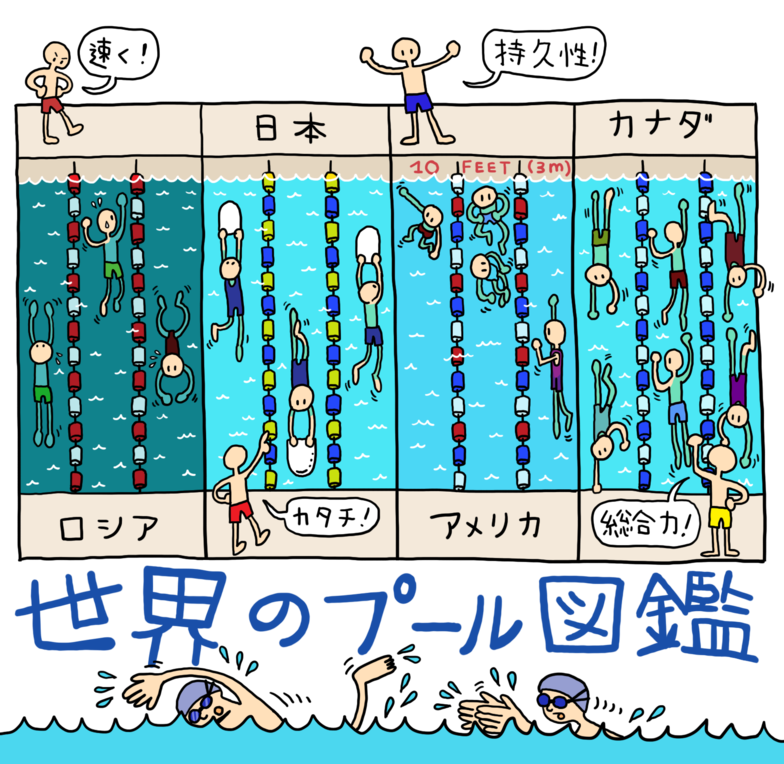I took swimming lessons from around age five until my second year of junior high school. When you think of swimming, freestyle, breaststroke, and backstroke come to mind—this is the same no matter where you go in the world. But actually, how swimming is taught and the goals set differ by country. I was made keenly aware of this on the very day I started attending a Japanese swimming school in fourth grade.
When I started swimming lessons at age five, pools in the Soviet Union weren't commonplace like in Japan, attached to most elementary schools. They were rare, with only a few scattered around town. The pool I attended had dark-colored tiles on the bottom. At a child's height, my feet couldn't reach the bottom, so I swam without truly understanding the depth. One day, the instructor announced, "Actually, there are sharks swimming at the bottom of this pool. Slow swimmers will get caught by the sharks and eaten. Don't slow down." Though we couldn't believe it, we were all pretty scared. Terrified, everyone swam at full speed. Every session left us utterly exhausted, but our swimming speed improved remarkably fast.
Years later, on my first day at a Japanese swimming school to resume lessons for my beloved swimming, I'd already mastered freestyle, breaststroke, and backstroke. I requested a class starting with butterfly. The instructor said, "Got it, show me what you can do!" So I swam 25 meters. Feeling quite pleased with my smooth stroke, I looked at the instructor proudly—only to be met with a shout.
Apparently, my form was all wrong. I was shocked. My speed should have been pretty fast. So why was he dissatisfied? The instructor continued, "You're starting over from the kickboard." Shaking with shock and anger, I made a proposal to the instructor. If I could swim faster than the fastest freestyle swimmer present today, he should just leave my technique alone.
The instructor hesitated for a moment, but the challenge was set. And I won. Great, I thought, now I'm sure I can learn butterfly. But it wasn't that simple. The instructor explained that in Japan, form is extremely important, with specific rules for when to breathe and which direction to face when lifting your head. He wouldn't budge. Consequently, I was forced back to paddle practice. My belief that just swimming fast was enough was completely overturned. Here, form mattered more than speed.
A year after the kickboard, I started attending an American swimming school. I had speed, and I'd built a solid foundation with the kickboard, so this time I was sure I'd learn butterfly. But first, the instructor told me to dive into the deep end of the pool. Then, she told me to just float there for ten minutes. Huh? Not swimming? I couldn't hide my surprise, but I tried it anyway. After a while, it started to feel pretty tough. I managed to get through it, but the instructor said, "If you keep this up, you won't last 30 minutes if you get swept out to sea!"
Here, I learned it's not about speed or form; what matters first is being able to float continuously, dive, and swim long distances. Form and breathing timing are flexible. Why? Because you gain the survival skills to endure if swept out to sea or nearly drown. You won't panic even in deep water.
This is something you can't learn in Japan's shallow pools. Swim long distances, even if it's slow. You also learn less tiring strokes like the "side stroke." The decision was that you couldn't learn butterfly until you mastered these. It was a bit frustrating, but now that I'd come this far, it seemed kind of interesting. I focused solely on mastering floating in the 3-meter deep end and the "side stroke."
Having mastered all this, I figured I had no complaints. A year later, I returned to a Japanese swimming school. Finally, I would learn the long-awaited butterfly stroke. It surprised me that even after becoming a strong swimmer, Japanese training still included paddle board drills. It must be to solidify the "fundamentals." While it might not make much sense for just enjoying a vacation swim, it's an excellent method if you truly aim to be a competitive swimmer.
Participating in a competitive development program in Canada made me realize something: the leg strength was completely different. My Canadian teammates often relied heavily on arm strength. Back in Japan, I had diligently built up my leg strength using a kickboard. It turned out that my leg strength, crucial for butterfly, made me faster than the kids I learned with in Canada.
Speed, form, endurance. All are important, certainly. But where should the emphasis lie, and why? What do we want children to learn through swimming? Why are we teaching it in the first place? Why do they want to learn it? Once you start thinking about these things, the best approach for you might naturally become clear. This, I think, might be something common to all sports and studies – a thought that's quite fascinating.




